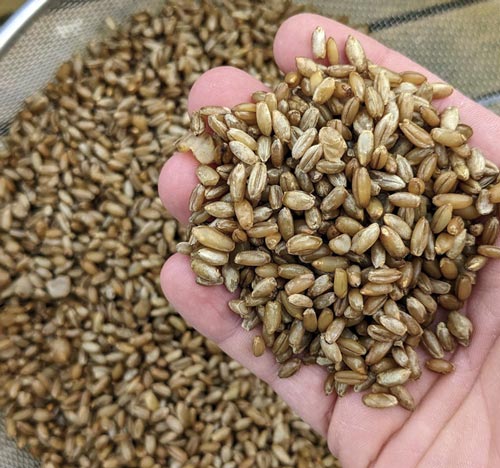Rye Grain Hydration
Correct Rye Grain Hydration is something quite a few growers talk about, but which is largely measured by guesswork. Of course, for many people, buying already sterilised and correctly hydrated grain is undoubtedly the easiest way to go. It saves a lot of effort, means you don’t need to worry about buying pressure cookers, suitable bags or containers and so on. It also saves a lot of time.
However, there are plenty of home mushroom growers who like to prepare their own grain and substrates. What we realised though, was that most people don’t know how to measure grain hydration.
 Depending on who you ask, you’ll be told that the optimum level of grain hydration (how much water is in the grain as a percentage of mass) is between 48% and 52%. We aim at 50% when processing rye.
Depending on who you ask, you’ll be told that the optimum level of grain hydration (how much water is in the grain as a percentage of mass) is between 48% and 52%. We aim at 50% when processing rye.
If you read articles online about rye grain hydration, the usual advice is to soak and boil your grain, then spread it out and leave it to dry until the outside of the grain is no longer visibly wet. That’s not wrong, but it’s not really right either.
There’s nothing wrong with judging hydration by eye, but working it out properly isn’t at all difficult.
Assessing Rye Grain Hydration
We’re looking at rye grain here, but the process and way of calculating hydration can be applied to other grain types too. Here’s how to do it..
The easy way: Buy a moisture meter to measure water content of the grain, for exact result. However, that’s money for something you’ll use once in a blue moon.
The longer way: Measure 100 grams into an oven-proof container and let the grain dry out on a low temperature setting overnight, then weigh what’s lefts. The final weight (let’s say 88 grams) will tell you that the evaporated water weighed 12 grams, or 12% of the initial weight. Using that information you would then follow the main guide below.
As a shortcut, avoiding the oven routine, you could just decide that the average water content of rye grain (yes it can vary according to supplier, storage humidity etc) is 12%, because it is.
The measuring bit
To illustrate how to measure hydration levels of rye, we’ll assume that you want to soak, boil and (afterwards) sterilise 1Kg of rye. We also assume the initial water content level of your dry grain is 12%. This means 1000 grams (1kg) of rye will contain approximately 12% or 120g of water and that the true dry weight of your grain is 88% of the total (1000g x 0.88 = 880g).
Having weighed out your grain, follow your usual soak and boil routine and then pour out your grain onto whatever you use to dry it on. We prefer to use brewers bags with dedicated drain stands that allow the bag to drain easily. The grain is turned in the bag several times while drying (you pick the bag up and simply shuffle the contents around, to make sure the grain dries evenly).
Once we’re happy the grains have started to dry, they are weighed. As a quick tip, for every 1kg of grain that we soak and boil, what you should be looking for is a ‘wet’ weight of 1.76Kg. With simple maths you can scale that up or down depending on how much grain you’re processing.
Calculating hydration levels
As above, we’ll assume you’re preparing 1Kg of rye grain. 1000 grams (1Kg) of ‘dry’ grain contains 12% water. So, its real dry weight is 800 grams. Soak and boil it in your usual manner and allow it to dry. A little bit before you think it might be properly dried, weigh your grain.
Let’s say in this case your grain weighs 1800 grams.
Find the true starting dry weight of the grain you started out with: (1000 x 0.88 = 880 grams)
Deduct the dry starting weight of your grain from the wet weight – (1800 grams total – 880 grams dry weight = 920 grams).
This tells you that the water content of your grain weighs 920 grams.
Divide this calculated water weight (920g) by the total wet weight of the grain (1800g) to see what % it makes of the total: (920 grams / 1800 grams = 51.1%)
In this case, in this example, your rye grain hydration level is 51.1%.
It’s that simple. By the time you’ve bagged up your grain or dispensed it into your containers it will dry out a little more, so starting that process when the hydration level is a little over your target is a good idea. If you’re simply bagging 1Kg, that only takes a few seconds, so waiting until hydration levels are perfect only means waiting a little bit more. Remember to ensure your grains dry evenly, of course. You don’t want some visibly dried out while others are soaked through.
